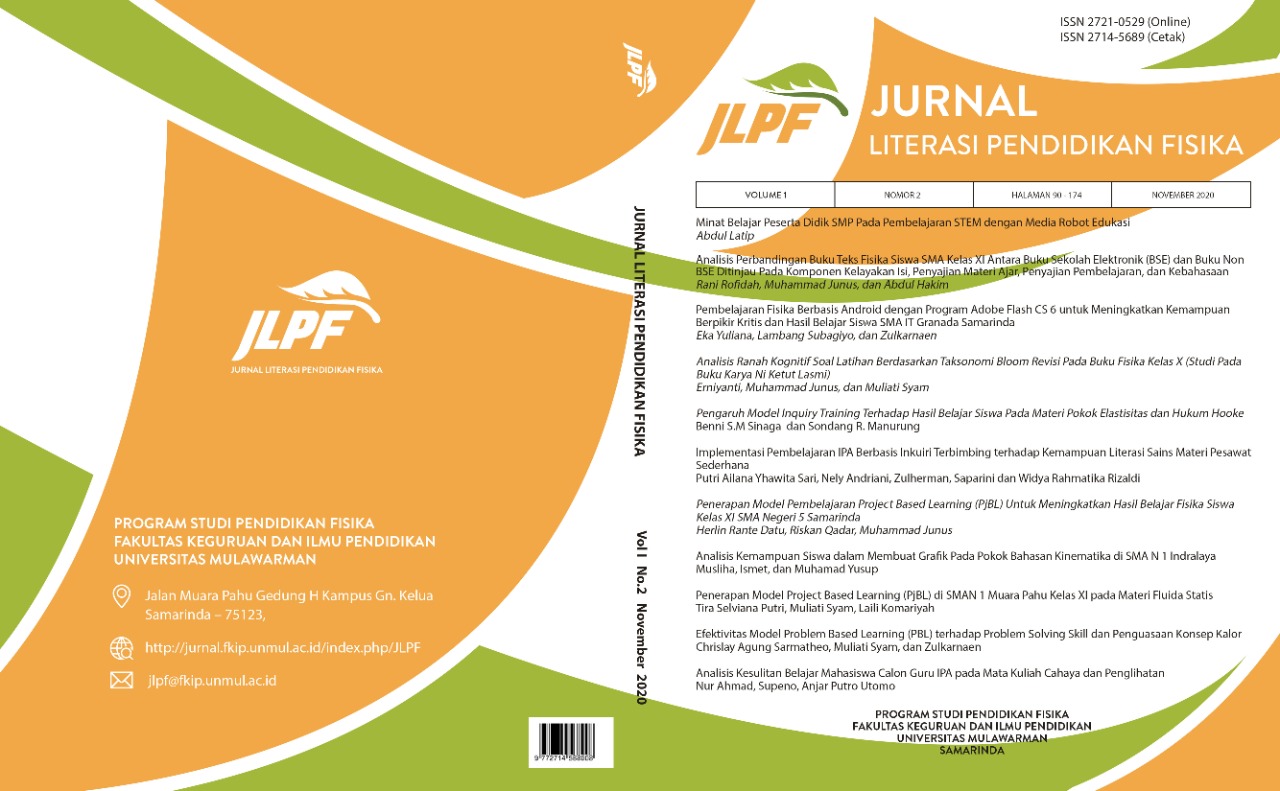Minat Belajar Peserta Didik SMP pada Pembelajaran STEM dengan Media Robot Edukasi
DOI:
https://doi.org/10.30872/jlpf.v1i02.353Keywords:
Minat belajar, STEM, RobotikAbstract
Penelitian ini bertujuan untuk menggambarkan minat belajar peserta didik SMP pada pembelajaran STEM dengan media robot edukasi (STEM-Robotik). Penelitian ini menggunakan metode deskriptif dengan sampel penelitian sebanyak 47 peserta didik SMP swasta di Kota Bandung yang mendapatkan pembelajaran STEM-Robotik selama satu semester. Instrumen yang digunakan merupakan kuisioner yang menggali 3 aspek minat belajar peserta didik dalam pembelajaran STEM-Robotik yaitu perhatian peserta didik, keterlibatan peserta didik, dan manfaat pembelajaran. Hasil penelitian menunjukkan bahwa, 1) Sebanyak 61,8% peserta didik memberikan perhatian yang baik dalam pembelajaran STEM-Robotik. 2) Sebanyak 73,4% peserta didik menunjukkan keterlibatan yang baik dalam pembelajaran STEM-Robotik, dan 3) Sebanyak 71,64% peserta didik mendapatkan manfaat yang baik dalam pembelajaran STEM-Robotik. Hasil tersebut menunjukkan bahwa secara umum peserta didik menunjukkan minat belajar yang baik dalam pembelajaran STEM-Robotik.
Downloads
References
Blackley dan Howell. (2019). The Next Chapter in the STEM Education Narrative: Using Robotics to Support Programming and Coding. Australian Journal of Teacher Education. 44(4), 51-64.
Cakir dan Guven. (2019). Arduino-Assisted robotic and coding applications in science teaching: Pulsimeter activity in compliance with the 5E learning model. Science Activities.https://doi.org/10.1080/00368121.2019.1675574.
Chen dan Chang. (2018). The Impact of an Integrated Robotics STEM Course with a Sailboat Topic on High School Students’ Perceptions of Integrative STEM, Interest, and Career Orientation. EURASIA Journal of Mathematics, Science and Technology Education. 14(12), 1-19.
Ebelit, R. (2012). “The Effects of a Robotics Program on Students Skills in STEM, Problem Solving and Teamwork. Science Education. Montana State University. Bozeman, Montana.
Eguchi. A. (2013). Educational Robotics for Promoting 21st Century Skills. Journal of Automation, Mobile Robotics & Intelligent Systems. 8(1), 5-11.
Gura, M. (2011). Getting Started with LEGO Robotics: A Guide for K-12 Educators. Retrieved 22 Dec. 2019, from http://www.iste.org/images/excerpts/ROBOTS-excerpt.pdf.
Jiea, et al. (2018). Integrated Robotics STEM Curriculum Towards Industry 4.0. International Journal of Human and Technology Interaction. 2(2), 17-23.
Karaahmetoglu dan Korkmaz. (2019). The effect of project-based arduino educational robot applications on students' computational thinking skills and their perception of Basic STEM skill levels. Participatory Educational Research (PER). 6(2), pp.1-14.
Khanlari. (2013). Effects of Educational Robots on Learning STEM and on Students’ Attitude Toward STEM. 2013 IEEE 5th Conference on Engineering Education (ICEED).
Lantz Jr., H.B. (2009). Science, Technology, Engineering, and Mathematics (STEM) Education What Form? What Function? Retrieved 20 December 2019, from http://www.currtechintegrations.com/pdf/STEMEducationArticle.pdf.
Latip, A., dan Hardinata, A. (2020). Implementation of STEM-Robotics as High School Intracurricular. Thabiea: Journal of Natural Science Teaching, 3(1), 11-19.
Latip, A., et al. (2020). Integration of educational robotic in STEM learning to promote students’ collaborative skill. J. Phys.: Conf. Ser. 1663. 012052.
Mosley, et al. (2016). Robotic Cooperative Learning Promotes Student STEM Interest. American Journal of Engineering Education. 7 (2), 117-128.
Sahin, A., Ayar, M. C., & Adiguzel, T. (2014). STEM-related after-school program activities and associated outcomes on student learning. Educational Sciences: Theory and Practice, 14(1), 309–322.
Permanasari, A. (2016). STEM Education: Inovasi dalam Pembelajaran Sains. Prosiding Seminar Nasional Pendidikan Sains (SNPS). 23-34.
Whitehead, S.H., (2010). Relationship of Robotic Implementation on Changes in Middle School Students’ Beliefs and Interest Toward Science, Technology, Engineering and Mathematics. Doctor of Education Dissertation. Indiana University of Pennsylvania.
Williams, K., Igel, I., Poveda, R., Kapila, V., & Iskander, M. (2012). Enriching K–12 science and mathematics education using LEGOs. Advances in Engineering Education, 3(2).
Downloads
Published
How to Cite
Issue
Section
License
JLPF (Jurnal Literasi Pendidikan Fisika) is an Open Access Journal. JLPF allows the author(s) to hold the copyright and to retain the publishing rights. The authors who publish the manuscript in this journal agree to the following terms:
Jurnal Literasi Pendidikan Fisika by Physics Education Program, Universitas Mulawarman is licensed under a Creative Commons Attribution 4.0 International License. This permits anyone to:
1. Share - copy and redistribute the material in any medium or format
2. Adapt - remix, transform, and build upon the material for any purpose, even commercially.
Under the following terms:
1. Attribution - You must give appropriate credit, provide a link to the license, and indicate if changes were made. You may do so in any reasonable manner, but not in any way that suggests the licensor endorses you or your use.
2. No additional restrictions — You may not apply legal terms or technological measures that legally restrict others from doing anything the license permits.






.png)







